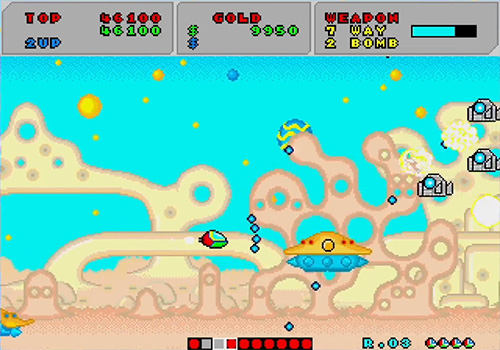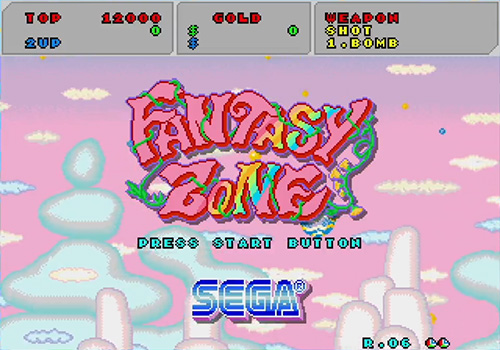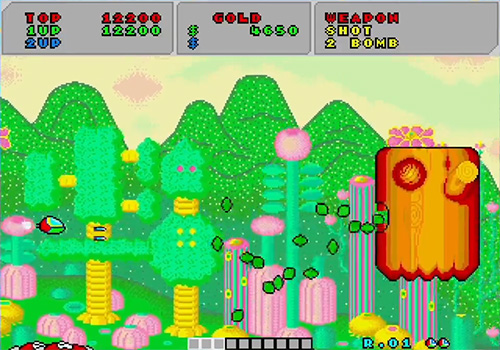幻想空間
《幻想空間》(Fantasy Zone)原為SEGA於1986年在街機System 16基板上推出的橫向卷軸射擊遊戲。以柔和的曲線、鮮明亮麗的粉彩色調與獨特的「可愛系射擊」風格而聞名,是日本遊戲史上最具代表性的Cute ’em Up 之一。後來本作被移植至多款家用平台,而Mega Drive版則由小西秀樹(Hideki “Hidecade” Konishi)負責移植,他同時也是Mega Drive《Darius》移植版的主要開發者。本版本的《幻想空間》忠實再現街機System 16版的風貌,是玩家與收藏者高度評價的版本之一,並作為「Mega Drive Mini 2」全機型的內建特典遊戲。
故事背景設定於B.G.1422年,宇宙世界的官方通貨突然陷入劇烈混亂,第九行星「Eldar」更因此爆發大規模經濟恐慌。經過Space Guild(宇宙協會)的調查,眾人發現貨幣被大量奪走的真相──神秘勢力正在控制「Menon 星人」,並以驚人的速度在名為「幻想空間(Fantasy Zone)」的領域內建造巨大戰鬥要塞。
為了阻止宇宙經濟崩壞,主角Opa-Opa(會飛的有機小型戰艦,也是SEGA曾經的吉祥物)奉命單獨前往幻想空間,摧毀當地的前線基地,並找出幕後真正的黑手。雖然故事簡單,但結合可愛又夢幻的畫面,使這個宇宙危機呈現出既奇妙又荒誕的魅力,也是本作深受玩家喜愛的原因之一。
Mega Drive版保留街機版的核心設計。以八方向搖桿操控 Opa-Opa,並使用兩個按鈕分別進行「射擊」與「投彈」。最具特色之處在於它採用「任意方向循環卷軸」的關卡設計,場景是環狀連接,玩家可以向左或向右移動,不論從哪個方向都能繞回起點。這在1980年代的射擊遊戲中相當少見,使得玩家能自由決定攻擊路線,帶來高度主動的操作感。
每個關卡會分散配置多個敵方前線基地,只要摧毀所有基地就會立即出現該回合的巨大BOSS。Mega Drive版與街機版相同,需要玩家反覆穿梭於環狀關卡,辨識雷達上的基地位置並逐一攻破。所有敵人與基地都會掉落大小不同的金幣,用於在商店購買零件與強化裝備。只要在關卡中遇到紅色的「SHOP 氣球」,Opa-Opa 即可進入商店購買速度提升、火力武器、炸彈武器甚至額外生命。這種「靠金錢購買強化」的系統讓遊戲節奏與策略性大幅提高,同時也使得每一次死亡都尤其沉重,因為 Opa-Opa 的所有購買裝備在死亡後會完全失去。
Mega Drive版為因應平台特性,畫面顯示的色彩數略低於街機原作,但仍維持極高還原度。更重要的是本作額外加入「Time Attack」模模式與全新的「Super Easy Mode」。Super Easy模式特別為輕度玩家打造,一開始就擁有15萬金幣、並擁有耐久度制的生命條,關卡通關後會恢復體力;金幣會自動吸向Opa-Opa,商店氣球也更常出現並且無消失時間,讓原本被認為偏高難度的遊戲變得更易上手。
儘管是家用版,在Mega Drive上依然展現強烈的街機風格。開發者保持高流暢度的捲軸速度與反應靈敏的操作手感,使Opa-Opa的速度與慣性完全符合System 16 的原始感覺。武器方面依舊包含像是Twin Shot、Wide Beam、Laser Beam與7Way Shot等射擊武器,以及Smart Bomb、Fire Bomb、Heavy Bomb等投彈系武器,玩家同時需在火力與速度間找到最適配的組合。
Mega Drive版尤其受到收藏者稱讚的是它的音樂重製。原本由川口博史與SEGA Sound Team創作的輕快、愉悅、帶有奇幻感的旋律在Mega Drive的FM音源下呈現出另一種質感,既保留街機版的歡樂基調,又增添更電子味與音色層次感。
自1986年首次亮相以來,本作便被視為SEGA射擊遊戲的象徵之一。它突破當時射擊遊戲以深色宇宙、冷酷戰爭為主題的框架,以明亮、夢幻、甚至近乎童話的世界觀呈現戰鬥,開創Cute ’em Up風格,也與《TwinBee》一起被視為此類型的奠基作品。Mega Drive版推出後,玩家普遍肯定其高程度還原街機原作的精神。不少評論者指出,本作在家用平台上完整保留街機的速度感與視覺魅力,甚至額外增加更親民的遊玩模式,讓新手也能享受原本偏高難度的遊戲內容。尤其是Mega Drive Mini 2將其作為內建遊戲,更讓本作重新受到新世代玩家矚目,成為經典復古遊戲收藏不可缺少的一款。
Fantasy Zone was originally released by SEGA in 1986 as a horizontal scrolling shooter built on the System 16 arcade hardware. Its soft, rounded shapes, bright pastel colors, and whimsical “cute ’em up” style quickly made it one of the most iconic titles of its genre in Japanese gaming history. The game was later ported to numerous home platforms, with the Mega Drive version handled by Hideki “Hidecade” Konishi, who had also worked on the Mega Drive port of Darius. This version faithfully reproduces the look and feel of the arcade original and is widely praised by both players and collectors. It was also included on every model of the Mega Drive Mini 2 as a bonus title.
The story unfolds around a monetary crisis faced by Opa-Opa. Set in the year B.G. 1422, the universe’s official currency suddenly collapses, plunging the ninth planet, Eldar, into a massive financial panic. The Space Guild’s investigation reveals that the cause of the crisis is a mysterious force manipulating the Menon race and stealing huge amounts of currency to construct a gigantic fortress within a region known as the Fantasy Zone. To prevent a total economic catastrophe, Opa-Opa—an organic, flying, sentient spacecraft and SEGA’s early mascot—is dispatched alone into the Fantasy Zone. His mission is to destroy the enemy bases scattered throughout the area and uncover the mastermind behind the crisis. Although the plot is simple, the combination of its adorable visuals and surreal setting gives the story an oddly charming and whimsical atmosphere, which has long endeared the game to fans.
The Mega Drive version preserves the core gameplay of the arcade title. Opa-Opa is controlled using an eight-direction joystick, with two buttons assigned to firing and dropping bombs. One of the game’s defining features is its freely looping stage design: each level forms a circular environment that the player can traverse either left or right, eventually looping back to the starting point. This was highly unusual for shooters of the 1980s and gave players a strong sense of freedom in choosing their attack routes. Within each stage, multiple enemy bases are distributed throughout the loop, and destroying all of them summons that round’s boss. Just like the arcade version, the player must constantly move through the circular map, using the radar to locate and eliminate each base.
Enemies and bases drop coins of various sizes and values, which serve as the game’s currency. These coins are used at the shop balloons that occasionally appear, allowing players to purchase speed upgrades, weapon enhancements, bomb types, and even extra lives. This “money-based power-up system” adds considerable depth to the strategy, as every death is costly—any equipment Opa-Opa has purchased is lost immediately upon being defeated.
Because of the Mega Drive’s hardware limitations, the color output is slightly reduced compared to the arcade original, but the port still maintains a remarkably faithful visual style. More importantly, it includes the Time Attack mode found in other versions, as well as an all-new “Super Easy Mode.” This mode is designed for casual players: Opa-Opa starts with $150,000, gains a life meter instead of dying in one hit, and fully restores health after each round. Coins are automatically attracted to Opa-Opa, and shop balloons appear more frequently and never disappear. This transforms what was traditionally considered a challenging game into something much more accessible.
Despite being a home version, the Mega Drive port retains a strong arcade feel. The scrolling remains smooth and fast, and the controls are precise, maintaining the same momentum and responsiveness seen in the System 16 original. The familiar weapons—Twin Shot, Wide Beam, Laser Beam, 7-Way Shot—and bomb types such as Smart Bombs, Fire Bombs, and Heavy Bombs are all faithfully reproduced. Players must strike a balance between firepower and mobility to survive.
Collectors and longtime fans especially praise the soundtrack of the Mega Drive version. The cheerful and whimsical melodies composed by Hiroshi Kawaguchi and the SEGA Sound Team gain a new texture through the Mega Drive’s FM synthesizer, retaining the lively spirit of the arcade tracks while adding a richer electronic tone.
Since its debut in 1986, Fantasy Zone has been regarded as one of SEGA’s defining shooters. It broke away from the dark, militaristic themes common in shooters of the time, presenting combat in a bright, dreamy, almost storybook-like world. Alongside Konami’s TwinBee, it helped establish the entire cute ’em up subgenre. The Mega Drive release continued to receive praise for how accurately it recreates the arcade original. Many reviewers commend the port for its visual faithfulness, responsive controls, and additional modes that help newcomers enjoy what was once a difficult game. Its inclusion on the Mega Drive Mini 2 has introduced it to a new generation of players, securing its place as an essential title for retro gaming enthusiasts.




運費計算方式:
貨款滿1000元運費外加90元
貨款1000以下:買1件運費外加 60元,買2件運費外加 70元,
買3件運費外加 80元 ,買4件運費外加 90元
貨到付款外加30元手續費
外島及大陸地區運費另計
付款方式:
線上刷卡:本站採用Paypal線上刷卡
虛擬帳號匯款:屬於您專屬的虛擬帳戶,方便站長查帳使用,本站強力推薦
實體ATM匯款:請將匯款帳號記錄下來至各大銀行ATM提款機轉帳
超商條碼繳費:請列印本站提供的條碼至四大超商繳費
線上轉帳:透過玉山銀行線上ATM轉帳(此系統只支援IE瀏覽器)
貨到付款:本站採用黑貓宅急便貨到付款
其他注意事項:
如需購買線上點數卡請直接跟站長連絡,本站不提供點數卡的線上付款

